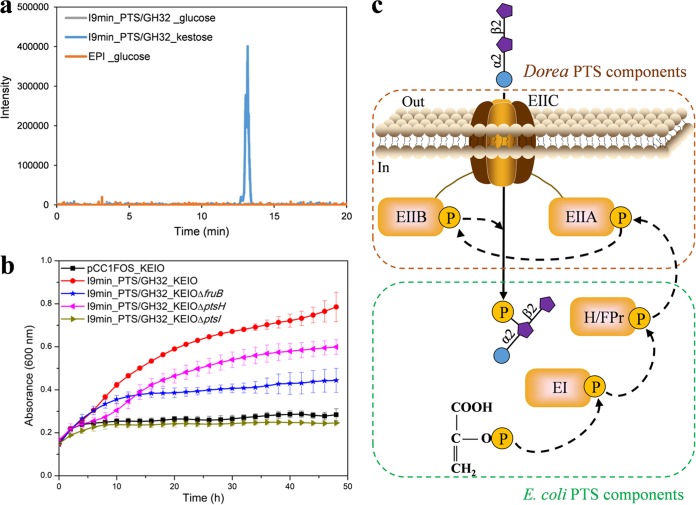FIG 6.
Functionality of the Dorea PTS in E. coli. (a) Extracted ion chromatogram (XIC) from negative ionization mode analysis at m/z 583.1270, corresponding to the exact mass of the [M-H]− ion of phosphorylated kestose (calculated from the molecular formula C18H33O19P). Color code: I9min_PTS/GH32 clone grown on kestose, blue line; I9min_PTS/GH32 grown on glucose, gray line; EPI grown on glucose, orange line. (b) Growth curves on FOS of E. coli K-12 BW25113 (KEIO) single-knockout mutants for PTS genes (ptsI, ptsH, and fruB) transformed with fosmid I9min_PTS/GH32. The KEIO wild-type strain transformed with the empty fosmid pCC1FOS was used as the negative control. HPr (histidine protein) encoded by ptsH is a cytoplasmic protein component of the E. coli glucose PTS. It accepts a phosphate group from EI (encoded by pstI), a cytoplasmic protein required for E. coli PTS functioning, and transfers it to the carbohydrate-specific EIIA domain. fruB encodes the HPr-like component FPr of the E. coli fructose PTS. These data represent the means from three biological replicates. (c) Schematic representation of 1-kestose transport and phosphorylation by the Dorea PTS complemented with the E. coli HPr, FPr, and EI component. As shown in panel a, kestose can be phosphorylated at different carbon positions, while only one form of phosphorylated kestose is represented here.

